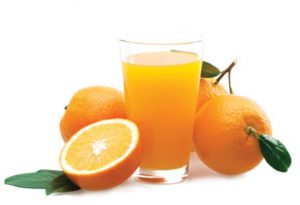Terpenes June 1, 2019
A MAJOR RENEWABLE AND SUSTAINABLE SOURCE OF FRAGRANCE AND FLAVOUR INGREDIENTS
 Sustainability issues are now at the top of the flavour and fragrance (F&F) industry agenda. Consumers increasingly require natural products obtained from renewable resources produced using sustainable processing methods. Terpenes are a major source of environmentally friendly and sustainable ingredients for the F&F sector. There are many thousands of terpenes found in nature but pine and citrus-derived terpenes are by far the most important as far as the F&F industry is concerned. These terpenes are obtained from plantbased origins and have clear advantages over unsustainable petrochemical based products, which have a substantially higher carbon footprint.
Sustainability issues are now at the top of the flavour and fragrance (F&F) industry agenda. Consumers increasingly require natural products obtained from renewable resources produced using sustainable processing methods. Terpenes are a major source of environmentally friendly and sustainable ingredients for the F&F sector. There are many thousands of terpenes found in nature but pine and citrus-derived terpenes are by far the most important as far as the F&F industry is concerned. These terpenes are obtained from plantbased origins and have clear advantages over unsustainable petrochemical based products, which have a substantially higher carbon footprint.
A combination of rising global demand alongside disruptions in the global supply chain for some major terpenes and F&F ingredients over the past two years has created supply problems and increased terpene prices, which still remain firm. This article discusses trends in the supply and demand for the two major sources of terpenes produced from pine trees and as orange by-products. In addition, there is a short discussion of the increasing use of biotechnology solutions to create terpenes.
TURPENTINE – A UNIQUE AND RENEWABLE RAW MATERIAL
 Many people do not realise how important turpentine from pine trees is as a source of supply for F&F ingredients – particularly fragrances. It remains the most plentiful essential oil in the world but it is a “by-product” constrained by inelastic supply. Some estimates suggest it accounts for approximately a quarter of the value of aromatic chemicals used by the F&F sector. Currently an estimated 316,000 MT of turpentine is produced globally, approximately two-thirds of which is further processed into F&F ingredients.
Many people do not realise how important turpentine from pine trees is as a source of supply for F&F ingredients – particularly fragrances. It remains the most plentiful essential oil in the world but it is a “by-product” constrained by inelastic supply. Some estimates suggest it accounts for approximately a quarter of the value of aromatic chemicals used by the F&F sector. Currently an estimated 316,000 MT of turpentine is produced globally, approximately two-thirds of which is further processed into F&F ingredients.
TURPENTINE PRODUCTION
Traditionally, there have been three sources of turpentine:
Gum turpentine, the volatile oil distilled from pine oleoresin, which is obtained from tapping living pine trees of the genus Pinus, either natural stands or increasingly pine plantations grown for timber or for producing paper pulp. Tapping can be undertaken throughout most of the year using a similar process to that used to tap rubber trees. The gum oleoresin obtained is separated to obtain two products; gum rosin and gum turpentine with an approximate 4:1 ratio. Both turpentine and rosin are used in a wide variety of applications. Since turpentine and rosin are jointly produced products, the economics and markets for rosin and its derivatives can impact on turpentine derivatives used in fragrances and flavours – and vice versa. Since rosin is not used by the F&F industry there is no further discussion here. Turpentine, rosin and derivatives obtained by tapping, used to be referred to as “gum naval stores” reflecting their use over many centuries in shipping. More recently the term “pine chemicals” is used.
Crude sulphate turpentine (CST) is a by-product recovered from the kraft chemical pulping of pine trees to produce paper.
Wood turpentine is extracted from aged pine stumps.

Current gum turpentine production is estimated at 125,000 MT but falling.
Portugal, USA and Spain used to be major producers but economic growth and labour issues in these countries
over the past few decades led to a substantial fall in production.
Production trends from these three sources have varied. Current gum turpentine production is estimated at 125,000 MT but falling. Portugal, USA and Spain used to be major producers but economic growth and labour issues in these countries over the past few decades led to a substantial fall in production. However, the trend in Spain has reversed recently following the severe economic downturn after the 2008 financial crash and in 2018 an estimated 18,000 MT of gum oleoresin was processed in Spain, some of which was imported. China produces turpentine in the growing regions of Guangdong, Fujian, Jiangxi and Yunnan, and accounts for approximately half global production. However, output has been falling for several reasons: reduced labour availability and higher cost, stricter environmental regulations, reduced competitiveness of gum rosin because of hydrocarbon resins. Meanwhile Chinese domestic consumption continues to rise, leading to it becoming a net importer. In contrast, Brazil, the world’s second largest producer, has seen a considerable expansion of pine forests over the last two decades leading to a growth in output and exports. Brazilian investment in R&D is leading to improved techniques and rising yields. Other producers include Indonesia, Vietnam, Argentina, Mexico and India. With limited availability of both pine forest resources and manual labour, improving the efficiency of forestry management and pine tapping techniques to produce pine oleoresin is a key issue for the future of pine chemical production.
Reduced availability of aged pine stumps has led to a dramatic fall in wood turpentine production over recent decades with current production estimated at only 6,000 MT, below 2% of global production. Because of the decline in gum and wood turpentine production, the market share of CST has increased, despite its relatively stable production. CST production is currently estimated at 185,000 MT.
TURPENTINE DERIVATIVES
Turpentine is mainly composed of terpene substances (hydrocarbons, esters, alcohols etc.): monoterpenes, (10C) and sesquiterpenes (15C). Some two-thirds of turpentine production is used to produce terpenes. The most common turpentine components are alpha and beta pinene, myrcene, limonene, and Δ3 carene, limonene and dipentene. However, gum turpentine as a natural essence has a varied composition depending on the species of pine tree and their geographical location. The table below illustrates the chemical composition of some pine species.

Thus, for example, over 95% of Chinese Pinus massoniana turpentine is composed of α– and β– pinenes. A wide range of derivatives can be obtained from processing α– and β– pinenes to create many F&F ingredients, some of which cannot be produced from petrochemical sources. These include:
Myrcene – myrcenol (lemon), iso-e-super (amber), lyral (lily of the valley)
– geraniol nerol (rose), citral (citron), ionones (rose, violet)
Pinene – pinanol, linalool (lily of the valley)
– citronellene, citronellol (rose), citronellal, menthol,
Hydroxyl -citronellal (honeysuckle)
Terpineol (pine, lilac) – methanol (woody)
Camphor aldehyde (sandalwood)
Camphene– isocamphylcyclohexanols (sandalwood)
Iso bornyl acetate
The remaining third of turpentine not used to produce terpenes for F&F ingredients has other uses. These include polyterpenes, mining applications, camphor, solvents or cleaning agents for paints and varnishes, which used to be the dominant use of turpentine. The joint production of a range of products combined with the potential substitution from alternative sources makes some of the end uses for turpentine very price sensitive. Thus, the rising prices of F&F terpene ingredients could lead to reduced utilisation of turpentine derivatives in other end uses. The most obvious example has been the decline in use of turpentine as a paint solvent, as the value and use of turpentine as a basic feedstock for the manufacture of a number of derivatives for use in the fragrance industry has increased.
GLOBAL SHORTAGES
Alongside growing global shortages of turpentine there have been other major recent disruptions in the supply chain for terpenes and F&F ingredients. In 2017 there was a fire at the BASF plant in Germany, which led to the fall in production of the key raw material citral from 60,000 MT to zero. In addition, there has been a delay in establishing the BASF plant in Malaysia. Meanwhile, there were two fires in Mahad in Maharashtra, India in 2018.
In February the DRT Anthea factory producing iso-e-super and DHM was put out of action for a year. Also in April 2018 there was a fire at the Privi factory that destroyed the ionone plant and hydrogenation unit. These factors contributed to the substantial rise in terpene prices in 2018. As the above discussion illustrates, the dynamics of the pine chemical market are complex. The growing demand for more environmentally sourced, ecological, sustainable, biological “green” products favours chemicals produced from pine forests with their renewable low carbon footprint. However, the availability of pine forests, particularly in Asia, combined with increased labour costs and inefficient collection techniques, is reducing pine oleoresin availability and raising prices. Despite the growth of pine chemical production in South America and Spain, mainly because tapping techniques are more efficient, the supply constraints will probably continue to increase in the near future.
ORANGE BY-PRODUCTS
 The other important source of terpenes is orange juice by-products, which includes essential oils, d’limonene and l-carvone. While fresh oranges and juice dominate the orange business there is a thriving and growing market for orange by-products, which in Brazil became significantly more important after 2013 and are estimated to account for some 7.5% of this multi-billion dollar business. Orange oil and terpenes are two important by-products from the production of the two main products FCOJ (frozen concentrated orange juice) and NFC (not from concentrate juice). On average some 49.2% of a Brazilian orange is peel, seeds and bagasse, 44.8% is juice, 1.8% is essential oil and 0.9% d’limonene and these latter two products have relatively high unit values.
The other important source of terpenes is orange juice by-products, which includes essential oils, d’limonene and l-carvone. While fresh oranges and juice dominate the orange business there is a thriving and growing market for orange by-products, which in Brazil became significantly more important after 2013 and are estimated to account for some 7.5% of this multi-billion dollar business. Orange oil and terpenes are two important by-products from the production of the two main products FCOJ (frozen concentrated orange juice) and NFC (not from concentrate juice). On average some 49.2% of a Brazilian orange is peel, seeds and bagasse, 44.8% is juice, 1.8% is essential oil and 0.9% d’limonene and these latter two products have relatively high unit values.
The dem and for orange derivatives (oil, terpenes and juice) is unbalanced in part because the market for FCOJ and NFC is decreasing. Meanwhile the demand for CPOO (cold pressed orange oil) and orange terpenes is increasing and the revenues from these derivatives are becoming more important. Demand is growing for several reasons: they are seen as “natural”, eco-friendly, with a low carbon footprint, while orange terpenes and d-limonene have been used to substitute for kerosene, acetone, and even turpentine, and their relative cheapness has seen their use as starting materials for chemical processes. For example, d-limonene/orange terpenes with their greener perception saw a major use in “fracking” fluids (a technique used to recover oil and gas from shale rocks) replacing petrochemicals. However, this has ups and downs based on oil price changes. Many of the uses for limonene/ orange terpenes are not price sensitive, most have few alternatives which means they ultimately pay whatever the market dictates. There are not too many uses that disappear as prices increase so demand is often slow to reduce as prices climb. Over the past two decades, the volume of exports of Brazilian orange oil and terpenes has shown a slight downward trend. Meanwhile, while prices have been volatile the trend has been upward, increasing almost 10-fold during this period.
and for orange derivatives (oil, terpenes and juice) is unbalanced in part because the market for FCOJ and NFC is decreasing. Meanwhile the demand for CPOO (cold pressed orange oil) and orange terpenes is increasing and the revenues from these derivatives are becoming more important. Demand is growing for several reasons: they are seen as “natural”, eco-friendly, with a low carbon footprint, while orange terpenes and d-limonene have been used to substitute for kerosene, acetone, and even turpentine, and their relative cheapness has seen their use as starting materials for chemical processes. For example, d-limonene/orange terpenes with their greener perception saw a major use in “fracking” fluids (a technique used to recover oil and gas from shale rocks) replacing petrochemicals. However, this has ups and downs based on oil price changes. Many of the uses for limonene/ orange terpenes are not price sensitive, most have few alternatives which means they ultimately pay whatever the market dictates. There are not too many uses that disappear as prices increase so demand is often slow to reduce as prices climb. Over the past two decades, the volume of exports of Brazilian orange oil and terpenes has shown a slight downward trend. Meanwhile, while prices have been volatile the trend has been upward, increasing almost 10-fold during this period.
BIOTECHNOLOGY SOURCES
Increasingly, biotechnology is becoming a major factor as it is being used to create natural F&F aroma ingredients through fermentation and other processes. A range of natural products (e.g. valencene, nootkatone, limonene) can be produced using sustainable and renewable resources (e.g. orange oil, glucose, yeast). For the moment, it appears to be only impacting high value products, such as valencene, nootkatone and vanilla, which are leading the way. However, it may gradually move down the value chain – but that’s a story for another day!
A list of sources used in preparing this article is available on request.
 Ultra International B.V.
Ultra International B.V.